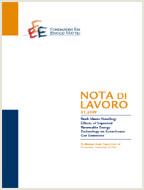Sustainable Cooperation in Global Climate Policy: Specific Formulas and Emission Targets to Build on Copenhagen and Cancun

03.07.2011
Valentina Bosetti, Jeffrey Frankel
Q54
Cancun, Climate, Concentrations, Cooperation, Copenhagen, Costs, Developing Countries, Development, Emissions, Equity, Global Climate, Global Warming, Greenhouse Gas, Human Development, International, Kyoto, Sustainable, Treaty, United Nations, WITCH
Climate Change and Sustainable Development
Carlo Carraro
We offer a framework to assign quantitative allocations of emissions of greenhouse gases (GHGs), across countries, one budget period at a time. Under the two-part plan: (i) China, India, and other developing countries accept targets at Business as Usual (BAU) in the coming budget period, the same period in which the US first agrees to cuts below BAU; and (ii) all countries are asked in the future to make further cuts in accordance with a common numerical formula to all. The formula is expressed as the sum of a Progressive Reductions Factor, a Latecomer Catch-up Factor, and a Gradual Equalization Factor. This paper builds on our previous work in many ways. First we update targets to reflect pledges made by governments after the Copenhagen Accord of December 2010 and confirmed at the Cancun meeting of December 2011. Second, the WITCH model, which we use to project economic and environmental effects of any given set of emission targets, has been refined and updated to reflect economic and technological developments. We include the possibility of emissions reduction from bio energy (BE), carbon capture and storage (CCS), and avoided deforestation and forest degradation (REDD+) which is an important component of pledges in several developing countries. Third, we use a Nash criterion for evaluating whether a country’s costs are too high to sustain cooperation.
